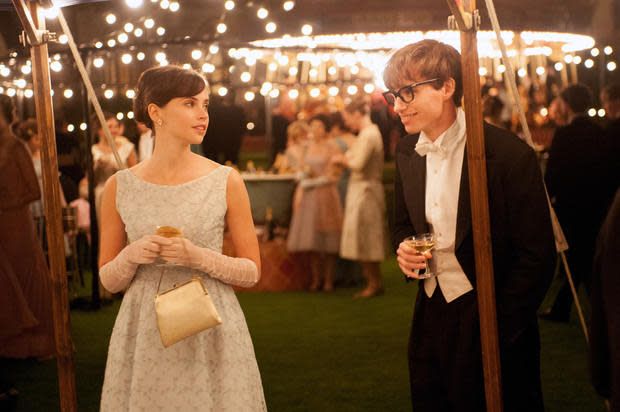'The Theory of Everything' producer reveals what makes this film unique

Felicity Jones stars as Jane Wilde and Eddie Redmayne stars as Stephen Hawking in "The Theory of Everything."
Photo Credit: Liam Daniel / Focus Features
"The Theory of Everything" is a new movie about the famous British theoretical physicist Stephen Hawking and Jane Wilde, the woman who married him. The movie describes the journey of their relationship -- it's a little like "A Beautiful Mind" meets "The Way We Were," plus the added element of astrophysics.
Despite being almost completely paralysed by motor neurone disease and restricted to using a voice synthesizer to communicate, Hawking has become a top scientist, author of many books, a family man, and even racked up acting roles in "Star Trek," "The Big Bang Theory," and "The Simpsons."
But the world may not know much about how Jane helped him achieve his accomplishments and keep his spirits up, and what price they paid.
The film's story
"The Theory of Everything" takes filmgoers on a unique journey that includes debilitating disease, love against all odds, and high science. "Stephen goes from being a lazy and unfocussed student to making the most of the little time he has left," said Lisa Bruce, one of the movie's producers. "Jane jumps off an emotional cliff to support Stephen."
The film covers key discoveries Hawking made. Bruce described a scene in the movie where Hawking had "a sweater stuck on his head. When his head popped out of it, he came up with this idea: black holes are not black at all. They emit radiation."
"The Theory of Everything" stars Eddie Redmayne as Stephen Hawking and Felicity Jones as Jane Wilde Hawking, and is directed by Academy Award winner James Marsh.
How accurate is "The Theory of Everything"?
A love story has universal appeal, but this movie is not simply a love story, and the science of black hole radiation is a tricky subject for the average moviegoer. How can the science in "The Theory of Everything" stick to the subject and not lose the audience?
The filmmakers enlisted the help of Jerome Gauntlett, a professor of theoretical physics, as a consultant. Gauntlett, a professor at Imperial College, London, wrote the formulas seen on the chalkboard behind the actors. So the formulas in the film do actually mean something, though possibly only the quantum mechanics lovers in the audience will understand.
Astrophysics for the rest of us
Bruce said the movie was "not made for brainiacs or scientists." The team wanted a general audience to "leave the picture with more of an understanding" of the science.
The movie simplifies theoretical concepts for laypeople, something Hawking has done a fair amount of in his career. Hawking wrote the best-selling science book "A Brief History of Time" to help non-scientists understand the concepts he worked on.
Bruce described how Hawking explained his theories to both the science community and to the general public. "He writes books with his daughter Lucy. And she writes books with her four children, bringing dense concepts to school kids."
Film's popularity is spreading through word of mouth
Bruce shared that "The Theory of Everything" has spread through cinemas a little like "The King's Speech" did. When it was first released in the US, "The Theory of Everything" was only shown in a few art-house cinemas in New York and Los Angeles. Shows spread as its fame grew by word of mouth, and as of this writing, it is now at 800 cinemas across America.
The movie has already been released in many countries, but unfortunately Europeans have to wait to see the movie until 2015.
Dr. Hawking likes the film
Hawking likes "The Theory of Everything," though he would have preferred to see more science, said Bruce.
So what's next for Hawking? According to Wired, Hawking wants to be a baddie in "James Bond." Movies. We love them.
Watch the official trailer
Also see
The open-source software Stephen Hawking says changed his life
Stephen Hawking: Humans evolve slowly, AI could stomp us out (CNET News)

